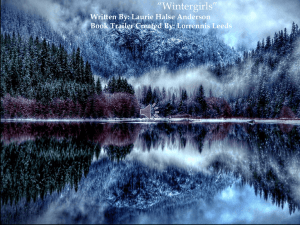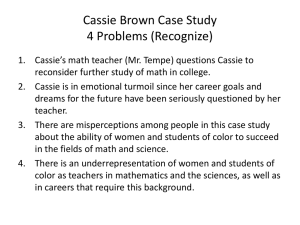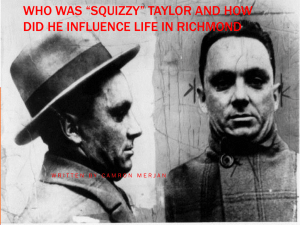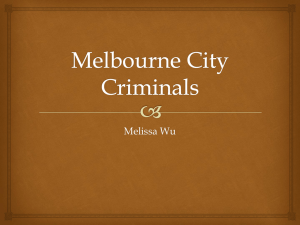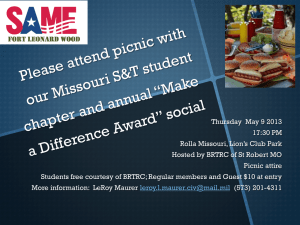presentation1mildred-taylor-lee214-9
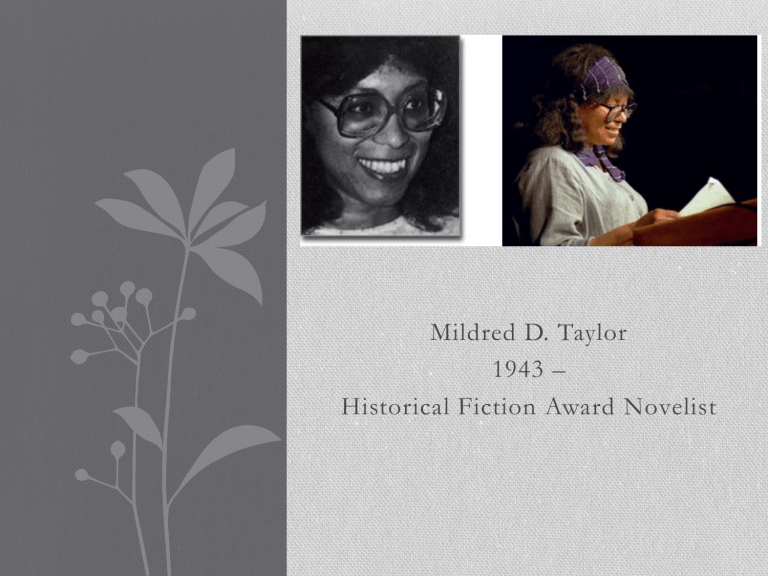
Mildred D. Taylor
1943 –
Historical Fiction Award Novelist
Biography
“I was born in a segregated city, in a segregated state, in a segregated America.”
• Mildred Taylor was born in Jackson, Mississippi on September 13,1943 and raised in Ohio.
• She grew up in an extended family that provided her with numerous stories and accounts of family experiences. Taylor remembers visiting her great-grandfather’s house built at the turn of the 20 th century that did not have running water or electricity. Memories from those visits provided Taylor with the narratives she descriptively retells.
• Taylor recalls taking difficult trips back to the South where she was born and experienced the realities of segregation.
• Although these trips were bittersweet, Taylor credits them with contributing to her rich experiences in telling her stories.
• Taylor acknowledges her father with instilling in both her and her sister with an understanding of both the past and their role in the future. “He wanted us to appreciate the good of the South as well as to be the thankful for the privileges and freedoms of our life in the North. Without understanding the loss of liberty in the South, we couldn’t appreciate the liberty of the North.”
• As a ten year old Taylor, moved into a newly segregated neighborhood in Toledo, Ohio. She was the only African-American child in her class, which caused her to be burdened and uncomfortable with the expectations to always perform well. Taylor was often ridiculed by her classmates when she retold stories of black history that contrasted with textbook information. “Most of the students thought I was making up the stories. They all believed what was in the history book.”
Biography
• During her high school days, Taylor became aware of many incidents related to the civil rights movement of the 1950’s. One in particular was the choice of homecoming queen at her high school, an African-American senior girl was selected. Emotions ranged from elation to anger and prompted racial violence.
“Though things returned to normal . . . those days of my freshman year hammered home to all of us that racism was not only part of the South, but of the North as well.”
• Taylor reported on Senator John F. Kennedy’s visit to Toledo and was impressed by his charm and sincere interests in the civil rights movement.
• Taylor continued her studies at the University of Toledo. She wrote her first novel at age nineteen, but it was never published.
• As a senior in college Taylor joined the Peace Corps and taught English as a second language on a Navajo reservation in Arizona and later traveled to
Ethiopia, where she taught at a rural school in the largest province.
• Later Taylor enrolled in the Graduate School of Journalism at the University of
Colorado and became involved with the Black Student Alliance and other organizations. Unhappy with the direction her life was taking, she returned to
Ethiopia.
Biography
• Upon returning from Ethiopia, Taylor moved to Los Angeles and held various jobs to support herself. She turned down an opportunity to be a reporter for
CBS to concentrate on her writing. She found success with a revised manuscript by winning a writing contest in the African-American category sponsored by the
Council on Interracial Books for Children.
• This revised manuscript served as the foundation for her first book featuring the Logan family, Song of the Trees.
• Taylor’s next novel, Roll of Thunder, Hear My Cry, continued the Logan family saga. And the story progressed with Let the Circle be Unbroken and The Road to
Memphis.
• Taylor recognizes her father for her literary success because of his storytelling ability and his refusal to succumb to racism and segregation.
• “Without his teachings, without his words, my words would not have been written.”
• Biographical Audio Link:
http://www.youtube.com/watch?v=5aGJVdgBGZs
• Mildred D. Taylor author study: http://barbkatz2.tripod.com/id14.html
Bibliography
•
Song of the Trees
•
Roll of Thunder, Hear My Cry
•
Let the Circle be Unbroken
•
The Friendship
•
The Gold Cadillac
•
The Road to Memphis
•
Mississippi Bridge
•
The Well: David’s Story
•
The Land
• Depression Era Photo Journey: http://www.youtube.com/watch?v=GOmYj6pKfVQ
• A Chronicle of Family Honor: Balancing Rage and Triumph in the Novels of Mildred
D. Taylor, by Karen Patricia Smith:
• http://comminfo.rutgers.edu/professional-development/childlit/books/SMITH.pdf
Bibliography
Awards
• 1973 - First prize – African-American category – Council on Interracial Books for Children
• 1975 – Outstanding book of the year citation – New York Times
• 1976 – Jane Addams Honor Citation – Song of the Trees
• 1976 – Notable Book Citation, American Library Association – Song of the Trees
• 1977 – National Book Award Finalist, Honor Book Citation, Boston Globe-Horn Book
• 1977 – Jane Addams Honor Citation
• 1977 – Newbery Medal – American Library Association, Roll of Thunder, Hear My Cry
• 1981 – Outstanding Book of the Year Citation, New York Times – Let the Circle Be Unbroken
• 1982 – Jane Addams Honor Citation – Let the Circle Be Unbroken
• 1982 – American Book Award nomination – Let the Circle Be Unbroken
• 1982 – Coretta Scott King Award – Let the Circle Be Unbroken
• 1985 – Buxtehuder Bulle Award – Roll of Thunder, Hear My Cry
• 1988 – Coretta Scott King Award, Boston Globe-Horn Award for fiction, The Friendship
• 1988 – Christopher Award, and New York Times – The Gold Cadillac
Awards
• 1988 – Children’s Book Council, special award for “a body of work that has examined significant social issues in outstanding books for young readers.”
• 1990 – Coretta Scott King Award – The Road to Memphis
• 1990 – Christopher Award – Mississippi Bridge
• 1996 – Jane Addams Book Award, Jane Addams Peace Council, The Well
• 1997 – ALAN Award
• 2003 – Inagural NSK Neustadt Prize for Children’s Literature
• Acceptance Speech for the ALAN Award: http://scholar.lib.vt.edu/ejournals/ALAN/spring98/taylor.html
Award Winning Books and their Summaries
The Well
“ You boys better start learning how to use your heads, not your fists, when it comes to white folks. You learn to outsmart them, ‘cause in the end you can’t outfight them, not with your fists.”
This novella is a prequel to Mildred D. Taylor’s Logan family saga. Like her other stories, The Well is set in rural Mississippi in the early 1900’s when David Logan is only ten years old. The weather is hot, dry, and well water is very scarce. True to their spirit of giving, the Logan’s well still has sweet water, which they kindly share with both black and white family neighbors. Charlie Simms is one of the meanest young white kids around and resents that the black Logan’s have plenty of well water. He makes life miserable for David and his older hot-tempered brother, Hammer. After Charlie hits David,
Hammer retaliates and both Logan brothers and the family find themselves in serious trouble. To avoid jail, as a consequence for an entire summer the Logan boys work on the Simms’s farm. However, once the patriarch Logan leaves town, Hammer beats up Charlie once again. Charlie’s anger fumes and he fights back with a vengeance that ends up hurting not only the Logan family, but also the entire community. The narrative concludes with an ironic twist of justice when Mr.
Simms discovers that Charlie pollutes the well, knocks Charlie down displaying his whip, and then orders Charlie and Ed -
Rose to climb into the well and clean it out while the Logan’s and rest of the community watch in disbelief.
Once again true to the criteria of historical fiction, Mildred D. Taylor’s writing evokes the feeling of the early twentieth century at a time when southern racism was normal and blacks had to be careful and avoid trouble from their white neighbors. The close-knit Logan family instills family values that demonstrate love, support, and wisdom, which attempt to protect family members from the offensiveness of racial prejudice. Unlike Taylor’s other stories told from the heroine
Cassie’s point of view, The Well is told from a young ten year old David’s point of view, differing in setting and voice, but however still embraces the same themes and conflicts that are evident in all her stories. True to form, The Well depicts the setting and characters with credibility through Taylor’s details of language and authentic dialect, “Y’all get y’alls water and y’all go on!” (p, 38). She also addresses family values and commitments, sense of community and belonging, religion, food, and references to slavery. Ma’s character is sensitive, yet wise as she shows her sympathetic side when she bakes molasses bread for the sheriff. Papa, David, and Hammer attend a pretend church service to spare a young man’s feelings. Stories of slavery told by Ma Rachel enable readers to feel “historical empathy” and understand the difficulties of the time period.
Award Winning Books and their Summaries
The Well
After some parental complaints of the use of the n-word in the narrative, some schools removed The Well from their reading lists. However, Taylor’s use of this word can be verified as authentic for the time period in which it was stated. Today this word is not “politically” acceptable, but in the spirit of her writing, the utterances of the n-word depict the real language of the setting and accentuate Taylor’s historical accuracy.
Charlie Simms threatens Hammer, “Well don’t y’all go gettin’ so prideful ‘bout that water, nigger! Maybe one day you won’t have it! Maybe one day y’all’ll find somethin’ dead floatin’ in it.” In this case, the discourse typifies the ways reality is perceived and understood using authentic language of the time period.
This authentic discourse also allows the reader to view a power struggle and control between the black
Logan family land owners and the white Simms family.
Taylor’s themes are similar in her stories and reveal universal truths about life, significance of family values and family relationships, characters are willing to take risks to help others, racial prejudice and discrimination, and the importance of land and land ownership. The theme of racism in The Well is much more visible and distressful than that of The Song of the Trees.
From The Well readers can better comprehend, trace the development, and gain insight into both David’s and Hammer’s characters as young boys and observe how their personalities and behaviors develop into the men they become later on in The Song of the Trees and Roll of Thunder, Hear My Cry. In addition The Well also provides readers insight into the causes of the deep-seated hatred the Simms have for the Logan’s as well as important insights into David’s and Hammer’s characters. Taylor cleverly creates her characters from the
“ground up”, which allows readers to see how they change from their very childlike beginnings to the mature men they evolve into.
Award Winning Books and their Summaries
Song of the Trees
“One thing you can’t seem to understand, Andersen,” Papa said, “is that a black man’s always gotta be ready to die. And it don’t make me any difference if I die today or tomorrow. Just as long as I die right.”
Song of the Trees is a historical fiction novel set in Mississippi during the depression era. It relates the story of the Logan family, told by Cassie, a young African-American girl, and her family’s conflict with Mr. Andersen, who coerces Big Ma and Mama to sell their forest of singing trees for a fraction of their worth. He attempts to cheat, take advantage, and threaten the two adult women into selling their precious trees. “I suggest you encourage Aunt Caroline to sell them trees, Mary. You, know, David might not always be able to work so good. He could possibly have . . . an accident.” During these economic hard times Cassie’s father works two states away in Louisiana on the railroad and sends money home monthly to his family. The family makes a profound decision and Cassie’s oldest brother, Stacey, rides for three days across the states to find his Papa. They both return to make an emotional and explosive stand against
Mr. Andersen and his lumbermen.
True to the criteria of evaluating quality historical fiction, this novella authentically depicts the rough times during the Great Depression. While the father earns a meager income working for the railroad in another state, Cassie and her family, Big Ma, Mama, Stacey, Christopher-John, and Little Man, live on a farm and support themselves by growing their own crops. Many clues in the story indicate the time period, kerosene lamps, clabber milk, and iron bellied stoves.
Children cry because there is not enough food to eat, folks in Mississippi are struggling to work, and daddies can not find enough work to feed their children.
Award Winning Books and their Summaries
Song of the Trees
The story is told in first person from Cassie’s point of view. From this character’s perspective reader’s can experience her emotions, thoughts, and actions first hand.
Through the eye’s of this young, impressionable child, readers sense her love for the trees, the ones that sing to her. Cassie’s age does not reduce the impact of the story, but rather enhances “historical empathy” for its young readers. The other family characters are believable as they bond to protect their land and unite against the antagonist, Mr.
Andersen.
As remembered from a family story, the plot of Song of the Trees is based on an actual incident that really occurred. Taylor often expresses her father’s stories of his childhood.
“His vivid description of the giant trees, the coming of the lumbermen, and the events that followed made me feel that I too was present.” The events and conflicts in the plot are authentic to the time period, the ever present danger of prejudiced white men taking advantage of black women and children, while grown-up men are laboring far away and many families are facing the economic hardships during the Depression. After Mr.
Andersen and his lumbermen have chopped down many trees, Papa returns home and makes a firm stand and emotional plea against him and saves the remainder of the trees.
Award Winning Books and their Summaries
Song of the Trees
Universal themes in this novella include racism and prejudice, poverty, strong family values and relationships, and standing up for one’s beliefs even though it may lead to unpleasant consequences. As revealed in Taylor’s other stories, the concept of power and authority between the black land owners, rare for that time, and the whites is apparent. It is a constant battle of racism and a struggle to keep the whites from overtaking the land. Young readers will empathize with the Logan family and perhaps agree with the children’s disrespect of Mr. Andersen and his lumbermen. The stings of racial prejudice from Mr. Andersen promote the family solidarity of joining forces against him and really all white people. Realizing that Papa is willing to risk his life to defend his family and his trees, Mr. Andersen retreats and yields to Papa for now.
The ending and resolution are plausible for the time being, as the Logan saga continues in Roll of Thunder,
Hear My Cry.
Mildred D. Taylor’s writing style is simple, yet effective. In this novella she demonstrates the frustrations of a poor black family and the concerns they feel for one another and nature and the environment, as well as the prejudice and greed of Mr. Andersen. She depicts Mississippi as it truly looked during the depression era, when it was demanding to make a living, and when people of power took advantage of those who had little. Taylor does not “sugar coat” the history of the Great Depression, but reveals the truths about it. In addition she creates a story that brings the spirit of family life in her descriptions of the patterns of daily routines and physical surroundings. The believable characters and their dialogue accurately portray the time period to evoke compelling images of the setting. And through Cassie’s eyes Taylor relates the dangers, threats, sadness, and triumphs of the Logan family, which young readers love to applaud for their victory against the evil of racism and prejudice.
Award Winning Books and their Summaries
Roll of Thunder, Hear My Cry
“There are things you can’t back down on, things you gotta take a stand on. But it’s up to you to decide what them things are. You have to demand respect in this world, ain’t nobody just gonna hand it to you. How you carry yourself, what you stand for – that’s how you gain respect. But, little one, ain’t nobody’s respect worth more than your own.”
Once again Mildred Taylor’s saga of the Logan family continues in her Newbery Award winning novel, Roll of Thunder, Hear My Cry, and reveals the intersecting themes of family values, loyalty, and importance of family standing up for one another with the relevance of land and land ownership. The
Logan family struggles to maintain the small farmland they have owned for several generations.
Cassie narrates the story from her point of view, which allows readers to experience her thoughts and feelings with empathy. As the Logan children walk miles to school, the bus carrying the white students whisk by them, splattering red mud on their clothes. Angry with this continuing treatment, the children scheme to trap the bus one rainy day. They dig a ditch in the road forming a rain filled pothole. The bus becomes stuck in the deep hole, breaking an axle, and forcing the white students to walk to school. The first day of school, Cassie supports her brother, Little Man when she learns that the black students will receive old, discarded books that the white students no longer need. Both
Cassie and Little Man are whipped for refusing the books. After school Cassie runs to complain to her Mama, who teaches seventh grade, but instead overhears Mama and Miss Crocker, the teacher, discusses the textbook problem. In the end, Mama agrees with Miss Crocker and the punishment.
However, Cassie glues white paper in the inside cover of the book to hide the word, “nigras”.
Award Winning Books and their Summaries
Roll of Thunder, Hear My Cry
The plot progresses as one night a caravan of cars approaches the Logan farm. At this time Cassie begins to comprehend the racial discrimination of blacks and becomes fearful of whites, whom she believed would never harm her. One day Cassie takes a trip to the town of Strawberry and wants to purchase an item from the local white owned store. She patiently and respectfully waits her turn to pay behind other customers, but she becomes shocked by the disrespect and disregarding behavior from the store owner when he acknowledges Lillian Jean, the young white girl, and ignores Cassie. Cassie’s temper overcomes her and she fights the white girl outside the store. Cassie’s grandmother, Big
Ma, forces Cassie to apologize, but one day Cassie schemes to fight back without using her fists, but her brains. Other serious complications develop, boycotting the Wallace store, the Wallace boys burning black men, Stacey fights with his best friend, T. J., and Papa and
Uncle Hammer (with a shiny new car) come home for Christmas. Harlan Granger, the local banker, urges the Logan’s to stop the boycott, but they refuse. Meanwhile Mama loses her teaching job, Papa’s leg is broken during a violent attack while he takes a trip to
Vicksburg. And only the hired hand, L. T., can defend the Logan farm and drive away the trespassers.
Award Winning Books and their Summaries
Roll of Thunder, Hear My Cry
Aggravated by the Logan’s behavior, Granger forces the family to pay up on a loan they once took out from the bank. Not wanting to lose their farm, Hammer sells his new car to make the payment. In the meantime, T. J. pals around with two trouble-maker white boys, who involve him in a murderous plot and frame him for the killing. The whites are enraged at this homicide and quickly decide to lynch T. J. Papa and L. T. attempt to stop the lynching that divides the community. As skies darken and the smell of rain in the air, they reach the tree, T. J., and mob of white folks. Off in the distance smoke is seen rising and the cotton fields are aflame, almost as if lightning had sparked the fire. In the spirit of community togetherness, the townfolk forget T. J.’s lynching and the blacks and the whites unite to stop the fire. What Cassie realizes in the end is that her Papa started the fire on purpose, because he had to do what he had to do. “Look out there, Cassie girl. All that belongs to you. You ain’t never had to live on nobody’s place but your own and long as I live and the family survives, you’ll never have to. That’s important. You may not understand that now but one day you will. Then you’ll see.”
Award Winning Books and their Summaries
Roll of Thunder, Hear My Cry
Mildred Taylor’s beliefs and attitudes once again are expressed in the novel through the character’s words, thought, and actions. The Logan family manages to successfully retain their farm, fight back against the tensions of racism, and survive another year and events with dignity. Over the course of this novel, Cassie’s character changes as she begins to understand the complexities of racism and discrimination and learns that she must fight against racism when it is possible and endure the treatment when necessary. More importantly, in Cassie’s character the theme of material independence is instrumental to maintaining one’s dignity and ethical independence. As a family the Logan’s sacrifice to own their own land, which allows them to gain opportunities that other black families do not have. Power and authority to maintain control in the community is a complicated conflict between blacks and whites that appears in this novel and other Taylor narratives.
The importance of family and family values are evident once again. The significance of family members and their contributions support each other in times of need. Uncle Hammer sells his shiny car in order to pay for the loan on the farmland, thereby keeping the farm in the Logan family. Cassie stands up for Little Man and his refusal to read the old, dirty textbook. The children band together, even though their plan was somewhat devious, to sabotage the school bus. Papa, Uncle Hammer, and L. T. fend off trespassers to save their home. Education is valued, the children attend school, receive books as Christmas gifts, and Mama teaches at the school. The Logan’s attend church and religion is supported by the only planned social event of the year, the annual revival.
Award Winning Books and their Summaries
Roll of Thunder, Hear My Cry
The accuracy of the setting is demonstrated through the detailed descriptions of cultural markers of the time period, the variety of foods, the lifestyles, and the Black southern dialect.
Taylor’s characters are credible and true to the setting. Because she bases her unique stories on those narrated to her by her father and grandfather, Taylor skillfully and realistically creates characters appropriate for the Great Depression. Her historical mastery permits readers to feel empathy with the characters and their conflicts. Believing that American history books did not genuinely portray the accomplishments of black people, Taylor works to incorporate her values and principles through the words, thoughts, and actions of her characters. Family values are passed down to Cassie and her brothers who witness their family members use wisdom and judgment in tough situations before taking action. As the narrator, Cassie demonstrates the survival and struggle to do what is right, even in the face of injustices. Even when Cassie is angry, she is smart enough to think of a more clever means to get revenge against Lillian Jean.
As the Logan children mature, they realize that there are more important values in life than just school fun and games; they begin to understand the racial hatreds and discrimination against blacks. Mildred D. Taylor writes with a passion that teaches powerful, historic lessons absorbed in a compelling narrative with honest characters, authentic dialogue, realistic settings, and from a young, naive character’s perspective that reveals universal life truths, which engages readers into the text that makes them feel that they are not studying history at all.
Seventh Grade Language Arts Collaborative Activity
Song of the Trees
Questions for Writing and Discussions
To demonstrate their understanding of The Song of the Trees, in small groups students will discuss, answer in writing, and orally share their responses.
Small groups receive three questions, one from each of these categories; one – responding to the text, two – making text – to – text connections, and three – making text – to – self and text – to – world connections.
Questions for discussion include:
1.
Describe a time you experienced a natural setting, perhaps camping, fishing, or hiking. Explain what you saw, felt, heard, smelled, and tasted. What does that imagery evoke and how can it relate to Song of the
Trees?
2.
What was the hardest accomplishment or sacrifice you had to make for your family? Explain in detail.
3.
What measures and to what extent would you take to protect a family treasure from someone of authority or more powerful than you and your family?
4.
Establish a set of family rules and values for 2013. Compare and contrast them to those of the
Logan’s family.
5.
Describe a period of time when your culture experienced racial discrimination and prejudice. Include as many details as you can recall. How does it compare with the Logan’s experiences?
Seventh Grade Language Arts Collaborative Activity
Song of the Trees
6.
Cassie talks about how old the trees are and the events they have witnessed through history. Choose a tree on our school grounds, imagine all the events that tree might have witnessed, and describe them in great detail.
7.
Cassie and her brothers are not respectful to Mr. Andersen and the lumbermen.
Determine those times when being disrespectful to adults is justified. Explain why you believe or do not believe disrespect toward adults is sometimes acceptable.
8.
Eleven year old Stacey left home riding a horse to get Papa in Louisiana. Predict and make inferences about Papa’s reactions when he returns home. Draw conclusions about how
Papa will resolve the problems against Mr. Andersen and the lumbermen.
9.
Consider the method Papa uses to get rid of the lumbermen. Is it a wise or foolish decision? Explain your choice with evidence. Determine another course of action Papa could have taken to scare the lumbermen off his land.
10.
What details and evidence in the story leads you to think the trees are so important to
Cassie? Are the trees just as important to Papa as they are to Cassie? Support your answer with evidence from the story.
Seventh Grade Language Arts Activity
Song of the Trees
11.
Mildred D. Taylor does not tell the events that Stacey encounters during his three day ride to find Papa.
Imagine what Stacey’s ride alone in the wilderness across several states would have been like and write your account in detail describing his thoughts and experiences.
12.
How did the Logan family cope with the difficult economic times of the Great Depression? These past several years during what economists call the Great Recession, many families experienced the same hardships. Compare and contrast the economic struggles of the Logan family and a present day family.
Consider employment, education, housing, transportation, food, and other kinds of expenses. Do you observe any trends and/or patterns?
13.
Song of the Trees ends with Papa surviving a showdown with Mr. Andersen. Who appears to be in more control/power? Hypothesize what Mr. Andersen and his employees might do to retaliate against the Logan’s? What evidence supports your response?
14.
Interpret David Logan’s statement, “A black man’s always gotta be ready to die.” Is there an instance/ cause that you would be prepared to die? Find at least three examples from history or another text that supports the context of David Logan’s statement.
15.
Locate references about land, people, places, and events from Taylor’s other stories that are similar to this one. Make connections between them and those of Song of the Trees. Using a Venn diagram, compare and contrast characters, their qualities, and attitudes, places, and events.
16. Determine the theme(s) of Song of the Trees and provide textual evidence to support your answer.
17.
Compare the themes of Song of the Trees and The Gold Cadillac from your 6 th grade textbook. Find textual evidence to support your opinion.
PERSONAL REFLECTION
Karen Mekenian – LEE 214 Literature for Children and Adolescents
Author/Illustrator Study Project
Mildred D. Taylor’s style of writing appeals to both adults and children as she effectively captures the history of her peopl e as retold by her father and grandfather. Her use of simple, yet authentic characters and their language contributes to the realities o f the setting and themes of family values, importance of land ownership, and racial discrimination. The reality of the words and human conditions reflects the history of the time period as she seeks the answers for truths and myths surrounding the plight of Af rican-
Americans. Although there were attacks on Taylor’s use of the n-word, she defends her word choices based on the authentic language of the South and justifies her use of them as showing reverence to and full understanding of the Civil Rights Movement. “But how can readers understand the true history of the past or the need for a civil rights movement unless they have begun to underst and the pain of those who suffered through slavery, discrimination, and segregation? How can readers feel the pain if I pretty up the way things were? I cringe at the thought of any child begin hurt by my words, but as much as it hurts me to write words of pain, I know that they must be written, for they a re truthful words about the time I write.”
Personally I believe Taylor’s intentions are grand in her attempts to relate, inform, and explain the truths about the myriad of experiences of African-Americans in this country, although they seem perhaps somewhat biased in presentation. Nevertheless,
Taylor’s interpretations of the South and treatment of African-Americans are still relevant in today’s world. To appreciate and comprehend the tumultuous world around us today, we must understand the atrocities of the past.
“The Well”, “Song of the Trees”, and “Roll of Thunder, Hear My Cry” were selected because the characters, settings, conflicts, themes, and to an extent, the points of view are similar. With their familiarity students enjoy reading and studying Song of the Trees, from the 7 th grade anthology and making connections to The Gold Cadillac, from the 6 th grade anthology. What makes Taylor’s stories so appealing is that readers discover that not only Taylor’s novels reveal issues of racial relations and prejudice in historical context, but also her books show that family, loyalty, friendship, and personal values can apply to children in today’s world as well. Readers fro m ages 10 and up can experience historical empathy as they learn about the past to appreciate the present and address the problems that may arise in the future. Challenges to readers include tracing the development of characters, comparing and contrasting conflict s and themes, and determining the importance of point of view. Taylor’s works have influenced many readers over the years and will continue to make an indelible mark in the world of literature.
Students’ reactions to Taylor’s novels.
http://www.allreaders.com/board.asp?BoardID=26620
References
•
http://www.ala.org/offices/resources/taylor
•
http://barbkatz2.tripod.com/id11.html
•
http://thebrownbookshelf.com/2008/02/11/mildred-taylor/
•
http://www.heinemann.com/shared/onlineresources/E00789/ additionalMaterial.pdf
•
http://kimbo1963.tripod.com/id26.html
•
http://www.olemiss.edu/mwp/dir/taylor_mildred/
•
http://cms.westport.k12.ct.us/cmslmc/resources/authorstudy/taylorbio.
htm
•


